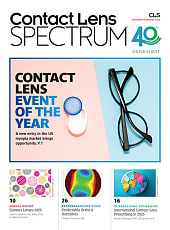ask the labs
Set ups & Specialties
by Karlen McLean, ABOC, NCLC
DEMO DYNAMICS
Q What's the best way to set up a PAL demonstration unit?
A Your lab can make an effective custom PAL demo for you. The objective is to have as many demo lenses in as few configurations as possible for the most efficiency and to avoid confusing patients.
The demo lens choices depend on what each practice wants, should be based on what products the practice uses most and wants to highlight, and should be a mix of lens materials and styles. There should also be products for comparison.
We'd suggest an FT28 bifocal, an FT trifocal, a round seg, and a regular PAL. The regular PAL should be the practice's favorite PAL; it doesn't matter if the PAL is free-form design or not for display purposes. A high index PAL in a -4.00D and a +4.00D aspheric poly would demonstrate thin and light PALs. Showcase the lenses in a high quality display case.
— Steve Seibert, president, Three
Rivers Optical, Pittsburgh
HIGH MAINTENANCE
Q What's the best method to process a high-cylinder lens?
A New state-of-the-art equipment has made it easier for labs to produce higher powered lenses at a higher quality.
The lens cutting process has become so precise that the curves have less elliptical error and the fining process works faster.
Using smaller frames allows for easier high-cylinder lens processing because we can crib lenses to a smaller diameter. This makes the fining and polishing of the blanks much easier.
We apply a heavy pin bevel to the lens, allowing water and polish to reach the center of the lens to maximize the performance of the fining and polishing process. This helps eliminate aberration. Proper shape and size during edging is critical so that when lenses are mounted into the frame, minimal front-side warpage occurs.
— Dennis Bruns, assistant manager,
Duffens Optical, Lenexa, Kan.
| Free-form forays |
|---|
| Q What are the different kinds of specialty lenses that free-form production can make? A The answer depends on how much programming someone is willing to do. Today's new generators can do just about any possible designed lens. Limitation is set by parameters from the manufacturers of the generators. It's possible to generate all types of lens designs including myo-disc, blended segs, high-minus curves, slab-offs, and many different free-form lenses depending on how much programming anyone wants to do. You are working with point files; it's not so much the limitation of the generators, as it is the cost of programming and polishing what you design. Thousands of dollars may be spent in programming, and you may not recoup your money, so having a programming plan is imperative. — John Haskins, president, Slabs Plus, Ruskin, Fla. |
If you have a question you'd like to have answered in Ask the Labs, send it to Karlen McLean. Email: mcleank@lwwvisioncare.com. Fax: 215-643-1705. An archive of past Ask the Labs columns can be found on the Eyecare Business Website at www.eyecarebusiness.com.



